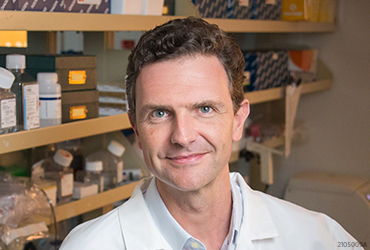Expecting the Unexpected
Growing up in Australia, Charles Mullighan knew he wanted to be a doctor but never thought about working in Memphis, Tennessee. But that is exactly where he ended up, at a hospital named for the patron saint of impossible causes.

“I think you have to expect the unexpected in a career,” Mullighan says of his scientific and professional journey, in which he earned his medical degrees (an MBBS and an MD) in Australia and did research in Oxford, England.
He was interested in hematology, acute leukemia in particular. At an American Society of Hematology conference, he met James R. Downing, MD, then head of pathology at St. Jude Children’s Research Hospital and now the president and CEO.
“St. Jude just seemed like a natural fit,” Mullighan recalls, although he didn’t intend to stay past his postdoctoral training. But he became deeply involved in the hunt for genetic factors in leukemia, joined the faculty, and started a lab.
It was then that he applied for the 2008 AACR-Aflac Career Development Award for Pediatric Cancer Research. His goal was to untangle the genetic influences in a particular type of B-lineage acute lymphoblastic leukemia—BCR-ABL1 ALL. This ALL subtype was shown to confer the worst prognosis in both adults and children.
His team found that ALL is characterized by a common epigenetic signature, and that each ALL subtype harbors a distinct epigenetic profile. They thus obtained the first comprehensive data demonstrating that gene expression profiles in ALL are directly determined by epigenetic alterations. Their findings meant that aberrant DNA methylation patterns weren’t secondary events but played an active role in forming tumors.
Mullighan’s laboratory found that the loss of the IKZF1 gene, which encodes a transcription factor called Ikaros, contributes to the development of high-risk BCR-ABL1 ALL. By screening more than 350 drugs, they found that retinoid-based agents reversed the effects of IKZF1 alterations and allowed the anticancer drug dasatinib to work, thus opening up new possibilities in treatment of this type of leukemia.
Mullighan forged ahead with the help of another grant from the AACR, the AACR Gertrude B. Elion Cancer Research Award, given in 2011.
“When you’re establishing a lab and really just getting momentum, it can be challenging to get the same sorts of grants the more established investigators get,” he says. “These career development awards from AACR are tremendously important. You could consider them a judicious bet on the next generation of researchers that are trying to make their mark. They can really catapult you at an early stage of your career to take your research to the next step and to make new findings and to really run with your initial discoveries.”
Mullighan long ago put aside any thought of leaving St. Jude and is deputy director of its Comprehensive Cancer Center and co-leader of the Hematological Malignancies Program. He is also medical director of the St. Jude Biorepository, a facility that stores more than half a million samples from pediatric cancer patients and supports 200 clinical trials worldwide.
St. Jude is famous as a children’s hospital, but Mullighan says the work goes across the age spectrum.
“A lot of what we’ve done, particularly over the last five years or so, has been not just to study pediatric leukemia at St. Jude and with the Children’s Oncology Group, but to work with many of the adult cooperative groups to study their patients, and samples from those patients, to understand how pediatric and adult leukemias are similar or different,” he says. “There are differences, but we’ve identified many similar findings as well that are equally applicable to leukemia that affects older individuals.”
For children with cancer, Mullighan notes, the cure rate has gone from 5 percent to 90 percent, but that’s taken 50 years. With that slow but steady progress in mind, he takes a long view of progress in medicine.
“Sometimes I think research findings can fall into the trap of being overhyped, that if someone has a wonderful study and a lot of expectations are built up, that this is going to be transformative for patient outcomes in a single-digit-year time frame. That’s often not realistic,” he says. “These very exciting, early discoveries then need to mature over time and really be tested [to determine] if they are therapeutic.”
Through it all, Mullighan still sees himself as a doctor.
“I still don’t see myself as a basic biologist,” he says. “I still see myself as a clinician that was interested in genetics, seeing it as a driver of disease.”
For further reading:
Integrated genetic and epigenetic analysis of childhood acute lymphoblastic leukemia, Journal of Clinical Investigation, 2013;123(7):3099-3111
Efficacy of Retinoids in IKZF1-Mutated BCR-ABL1 Acute Lymphoblastic Leukemia, Cancer Cell, 28, 343–356, September 14, 2015